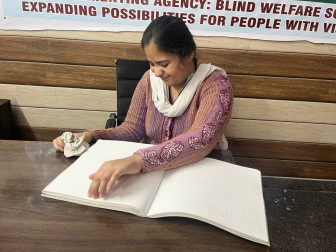Designing for Inclusion: How to Make Your Home More Accessible for Visually Impaired Individuals
Creating an accessible and inclusive home is essential for ensuring that visually impaired individuals can navigate their living spaces safely and independently. By integrating thoughtful design elements, you can make your home more accommodating and welcoming. This blog provides practical tips and strategies for designing a home that meets the needs of visually impaired residents and guests.
1. Understanding Accessibility Needs
Key Considerations
- Navigation and Safety: Ensure that visually impaired individuals can move around the home safely and with ease.
- Functional Layout: Design spaces to be intuitive and easy to navigate, reducing the likelihood of accidents or confusion.
- Sensory Cues: Use tactile, auditory, and olfactory cues to assist with orientation and identification of different areas.
2. Enhancing Visibility and Contrast
Lighting
- Consistent Illumination: Ensure that all areas of the home are well-lit with consistent and glare-free lighting. Use adjustable lighting fixtures and consider motion-sensor lights for ease of use.
- Task Lighting: Provide additional lighting for tasks such as reading or cooking to ensure that these activities can be performed safely.
Color Contrast
- High Contrast: Use high-contrast colors for walls, floors, and furniture to help visually impaired individuals distinguish between different surfaces and objects. For example, choose dark furniture against light walls or vice versa.
- Contrast in Fixtures: Ensure that switches, handles, and other fixtures are easily distinguishable from their backgrounds through contrasting colors or textures.
3. Tactile Markings and Braille
Tactile Cues
- Textured Surfaces: Use different textures for flooring and wall surfaces to help with spatial orientation. For example, carpet in certain areas and smooth flooring in others.
- Tactile Guides: Install tactile strips or markers on the edges of stairs and at doorways to help with navigation and prevent accidents.
Braille Labels
- Labeling: Add braille labels to doors, switches, and important appliances to provide clear identification and enhance independence. Use durable materials and ensure labels are properly placed and easy to read.
4. Accessible Furniture and Layout
Furniture Arrangement
- Clear Pathways: Arrange furniture to create clear, unobstructed pathways that are easy to navigate. Avoid placing furniture in high-traffic areas or where it may obstruct movement.
- Stable Furniture: Ensure that furniture is stable and won’t tip over easily. Avoid sharp edges or corners that could pose a risk of injury.
Adjustable Furniture
- Ergonomic Design: Choose furniture that is adjustable and can be adapted to the needs of visually impaired individuals. For example, adjustable-height desks and tables can provide flexibility in different activities.
5. Kitchen and Bathroom Accessibility
Kitchen Design
- Accessible Appliances: Use appliances with tactile controls and audible feedback. Consider appliances that offer voice activation or have large, easy-to-read buttons.
- Counter Height: Ensure that counters and cabinets are at accessible heights. Use pull-out shelves and drawers to make items more reachable.
Bathroom Design
- Grab Bars and Non-Slip Surfaces: Install grab bars and non-slip flooring to enhance safety and prevent slips or falls. Ensure that these are securely installed and easily accessible.
- Accessible Fixtures: Use lever-style faucets and easy-to-reach controls for showers and baths. Consider adding a shower bench or seat for convenience.
6. Technology and Smart Home Solutions
Voice-Activated Devices
- Smart Assistants: Incorporate voice-activated assistants and smart home devices to help with controlling lighting, appliances, and other home functions through voice commands.
Accessibility Features
- Smart Technology: Explore smart home technology that offers accessibility features such as audible alerts, automatic door openers, and remote-controlled systems.
7. Personalization and Flexibility
Personal Preferences
- Individual Needs: Consider the personal preferences and specific needs of the visually impaired individual when designing the space. Customization can greatly enhance comfort and usability.
Flexible Design
- Adaptable Spaces: Design spaces that can be easily adapted or reconfigured as needs change. This flexibility can ensure long-term accessibility and comfort.
8. Testing and Feedback
User Testing
- Feedback: Involve visually impaired individuals in the design process to gather feedback and ensure that the solutions meet their needs. Conduct regular testing to identify any potential issues or areas for improvement.
Conclusion
Designing a home for inclusion and accessibility is a vital step in creating a supportive environment for visually impaired individuals. By focusing on visibility, tactile cues, accessible furniture, and incorporating smart technology, you can create a space that promotes independence, safety, and comfort. Thoughtful design ensures that all individuals can navigate their homes with confidence and ease.

.jpeg)
